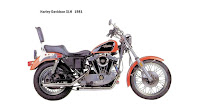 |
| 1953 Indian Chief |
 |
| 1971 Norton Commando |
devastation of World War II and were beginning to erode Harley’s dominance of the market. Also as we covered in the last post Honda had achieved amazing success with its lightweight and gas stingy models expanding its dealer network to over 500 outlets by the mid 60’s. Looking to raise capitol and improve its financial position the long time family owned business went public and became a stockholder corporation, while retaining controlling interest in the business. Unfortunately years of a outdated business plan couldn’t be overcome by merely becoming a stock corporation and when American Machinery and Foundry Company (AMF) began making buyout offers to the Davidson Family and in 1969 AMF took over operation of Harley Davidson.
 At first the AMF buyout achieved amazing success, boosting the sale of 27,000 units in 1969 to a high of 60,000 units (including Aermacchi) by 1972. But as many a Harley enthusiast has pointed out motorcycles ain’t bowling balls (one of AMF’s divisions made
At first the AMF buyout achieved amazing success, boosting the sale of 27,000 units in 1969 to a high of 60,000 units (including Aermacchi) by 1972. But as many a Harley enthusiast has pointed out motorcycles ain’t bowling balls (one of AMF’s divisions made bowling equipment) and the company began to falter from lack of experienced management at all levels and the quality of the Harley’s being produced suffered, actually the word suffered is an understatement. To put it bluntly Harley Davidson motorcycles had fallen so far as to become the butt of jokes, with satirical references to the iconic HD like “Hardly Driveable,” and “When doesn’t a Harley leak oil? When its empty of course.” Incredibly thought, the AMF Harley’s would post a record sales figure of 50,000 units (all large V-Twin models) in 1979, but as they say, “it was the crest of the wave.”
 |
| 1981 Honda Gold Wing 1100 |
 |
| The Original HD Buyers Group |
 |
| 1981 Sportster |
Thompson and Vaughn Beals pictured in the photo with “Willie O.” Now Harley had dedicated owners who had great enthusiasm but very little cash and the dream was almost over before it started. When HD posted a twenty-five million dollar loss in 1982 Citibank became nervous over the state of the company. The buyers group in an effort to reduce the loss froze salaries, cut officers salaries and laid off over four-hundred employees. Vaughn Beals was quoted as saying “we were trying to work with a production system that was basically flawed” and knew that something had to be done and done quickly.
 |
| The now closed USA Honda Plant |
songs; it was professional managers who understood their business and paid attention to detail.”
The HD executives came away from the visit determined to emulate the Japanese production methods completing one of the great paradoxes of all time. It seems this marvelous system of production was not a Japanese invention at all, but the brain child of two American industrialists named Dr. Edwards Deming and Joseph Juran who after World War II were charged with the rebuilding of the Japanese economy and industrial production. So you see Harley Davidson borrowed a system that was really American in origin to start with, which I hope will make the Harley faithful feel a little less betrayed.
Next Harley Davidson did what many consider a move that should be employed against the Chinese today, they went to the politicians and asked for an increase in the tariff on foreign motorcycles over 700 cc displacement, President Reagan agreed and raised the tariff from 4.4% to a whopping 49.4%. In the following years Harley Davidson made great strides in quality control, along with new more updated designs that emanated from the mind of “Wille O.” The turn around
was well underway when in 1987 Harley Davidson executives did something truly extraordinary, they voluntarily asked the government to roll back the tariffs it had placed on the Japanese firms back in 1983.
 |
| All the Goodies! |
 |
| "Willie O" for President! |
Today Harley is still moving in the right direction although the recession that started in 2008 nearly put an end to all the hard work. The hero this time was billionaire Warren Buffett when his company Berkshire Hathaway provided Harley with a much needed loan that kept the company afloat. Here’s hoping that HD’s next hundred years are as profitable and productive as their first hundred. There are certainly hurdles to be met but it just wouldn’t be the same if loud pipes and the iconic HD image were to fade into history.

No comments:
Post a Comment